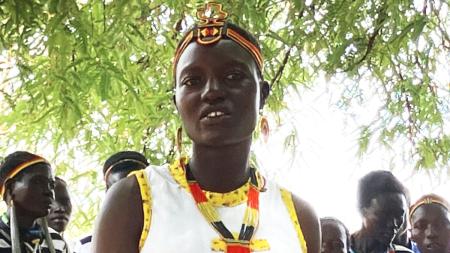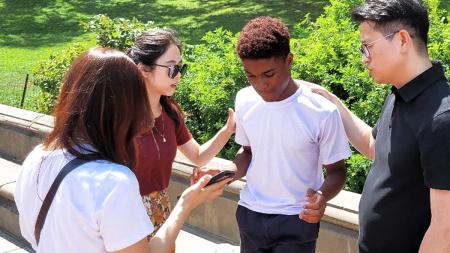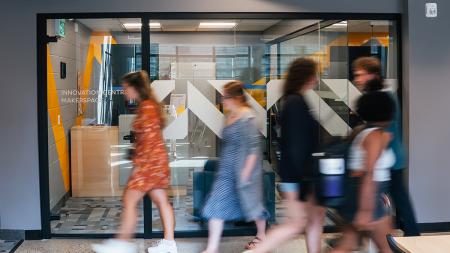Worship Symposium Concludes

The final worship service at Symposium on Worship
Calvin Institute of Christian Worship
On the final day of the 29th annual Symposium on Worship, at a plenary session titled “Improvising New Life: Why Tradition and Innovation Belong Together in Christian Theology and Worship,” Calvin Institute of Christian Worship associate director Kathy Smith welcomed those gathered in the Covenant Fine Arts Center Auditorium to a day of learning, conversation and worshiping together.
Her words were an aptly described the entire conference, an event sponsored by the the Calvin Institute of Christian Worship (CICW) and the Center for Excellence in Preaching that brought 1,500-plus people to Grand Rapids, Mich., in late January, people who hailed from 40-plus states and provinces, another 40 or so countries and almost 50 different denominations and Christian traditions.
Many, almost half, came for the first time, but almost 300 had been five or more times in the past. They represented churches, to be sure, but also seminaries, college and high schools. Some came from urban areas and others from rural settings. They represented both formal and informal worship service styles, big churches and small, churches that are thriving and churches that are simply surviving.
At the symposium, they attended some 100 workshops, worship services, seminars, plenary addresses, art exhibits and more led by more than 90 presenters who also represented a wide variety of places, races, organizations and Christian traditions.
Where Do I Belong?
Still, despite the differences, attendees had much more in common than even they may have realized when the conference began. At an opening worship service on the first day of Symposium, when Calvin chaplain Mary Hulst identified precisely where those gathered find their identity, a Calvin chapel full of attendees nodded in affirmation.
In a sermon titled “Where Do I Belong?”– based on Isaiah 43:11-7– Hulst spoke of the many questions she often hears from college students, questions that at their core are rooted in a deep desire to belong.
But the questions surrounding belonging don’t end when college is complete, she said. Indeed, for many the question of where one belongs can last a lifetime.
She added, to appreciative laughter: “I think this question is particularly poignant for those of us who are professionally religious.”
Sometimes, Hulst continued, folks such as symposium attendees – pastors, worship leaders, choir directors, youth group leaders, teachers, professors and many more – feel like they don’t belong.
“We feel like employees,” she said. “We feel stuck.”
Isaiah 43, she noted, is a word of comfort for people who are stuck.
“Jesus did not give his life so you could belong to a church or so the church could belong to you,” she said quietly. “God says I’m crazy about you. Do not fear. You belong to me.”
Living in the "Someday"
That sense of belonging also was at the heart of Barbara Newman’s plenary address on “Universal Design for Worship: Shaping Worship for People of All Abilities.”
In her talk, Newman, a church and school consultant for the Christian Learning Center Network in Grand Rapids and author of Accessible Gospel, Inclusive Worship, challenged her listeners to extend the architectural standards of universal design (make buildings accessible from the start) to the worship services that conference attendees plan and lead.
“What if we didn’t need to retrofit our planning to be accommodating to persons at all levels of ability and disability,” she asked, “but planned them that way from the start?”
What would it look like, she was asking, if everyone in your church, including visitors, felt like they belonged?
And belonging certainly was present in the Center Art Gallery on Calvin’s campus where two exhibitions drew steady streams of conference attendees. "Come to the Table," a traveling exhibit by Christians In the Visual Arts , featured 35 carefully selected works in a variety of media and celebrated both the rich community gathered at the Table of Fellowship and the privilege of meeting with God at the Table of Communion.
It included numerous striking pieces, many of which explored the idea of belonging. For example, there was “Gathered” by Barry Sherbeck, which said simply: “From our earliest days we seek to belong.”
Several presenters noted that Christians live and seek belonging in the present, in the places to which they are called to make a difference, but also place their hope in and belong to a promised future.
In a powerful sermon, Frank A. Thomas, director of the Academy of Preaching and Celebration, Christian Theological Seminary, Indianapolis, Ind.. preached on Isaiah 61, noting that as Christians it’s often appropriate to despair at the current circumstances and the ways in which things never seem to change.
“We wear sackcloth,” he said. Yet, he noted, Christians also live in the bright hope of tomorrow, the “someday” promises of the Bible.
And at the “Improvising New Life: Why Tradition and Innovation Belong Together in Christian Theology and Worship” plenary address, which used live jazz music to demonstrate tradition and innovation in action, L. Gregory Jones, a professor of theology at Duke University, sounded many of the same notes.
Like the Old Testament Israelites, he said, Christians today seem often to be preoccupied with “going back to Egypt,” to the familiar even though it might be painful. He encouraged his listeners instead to believe in a God who is pure innovation and a Spirit erupting into the world, making all things new.


